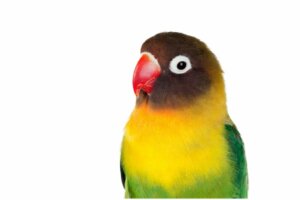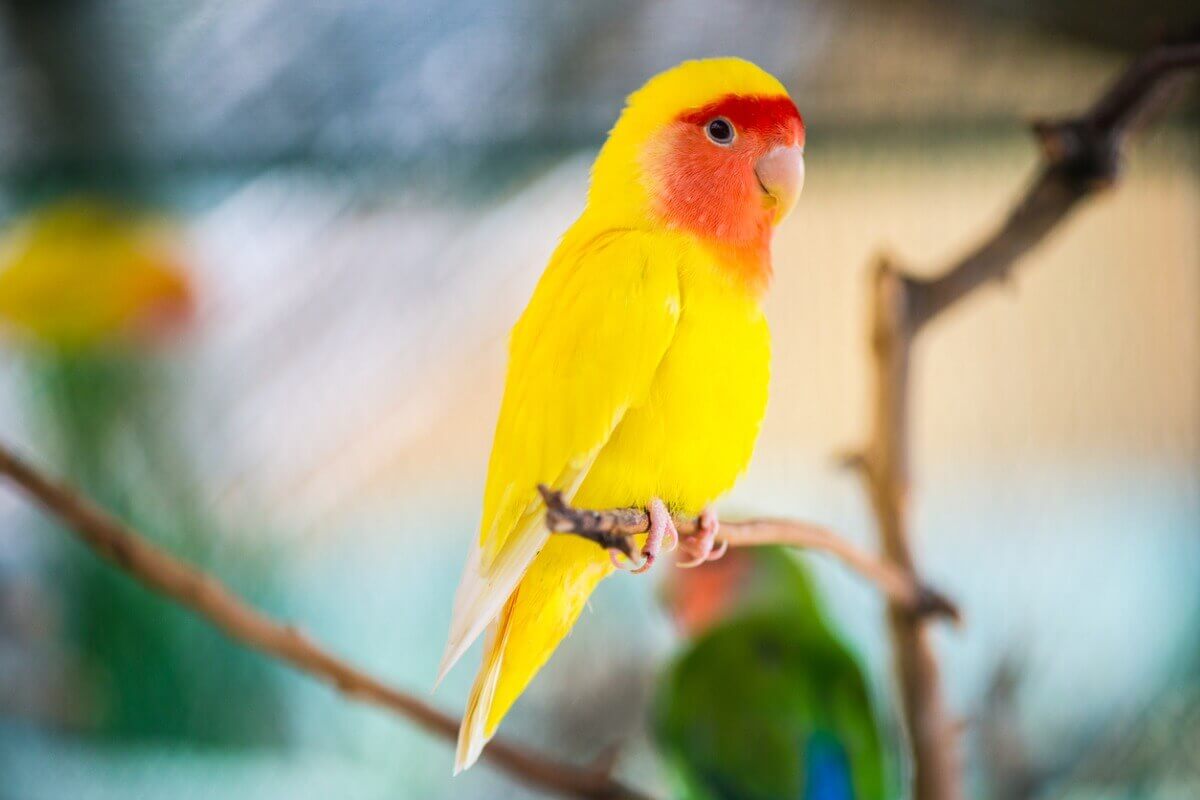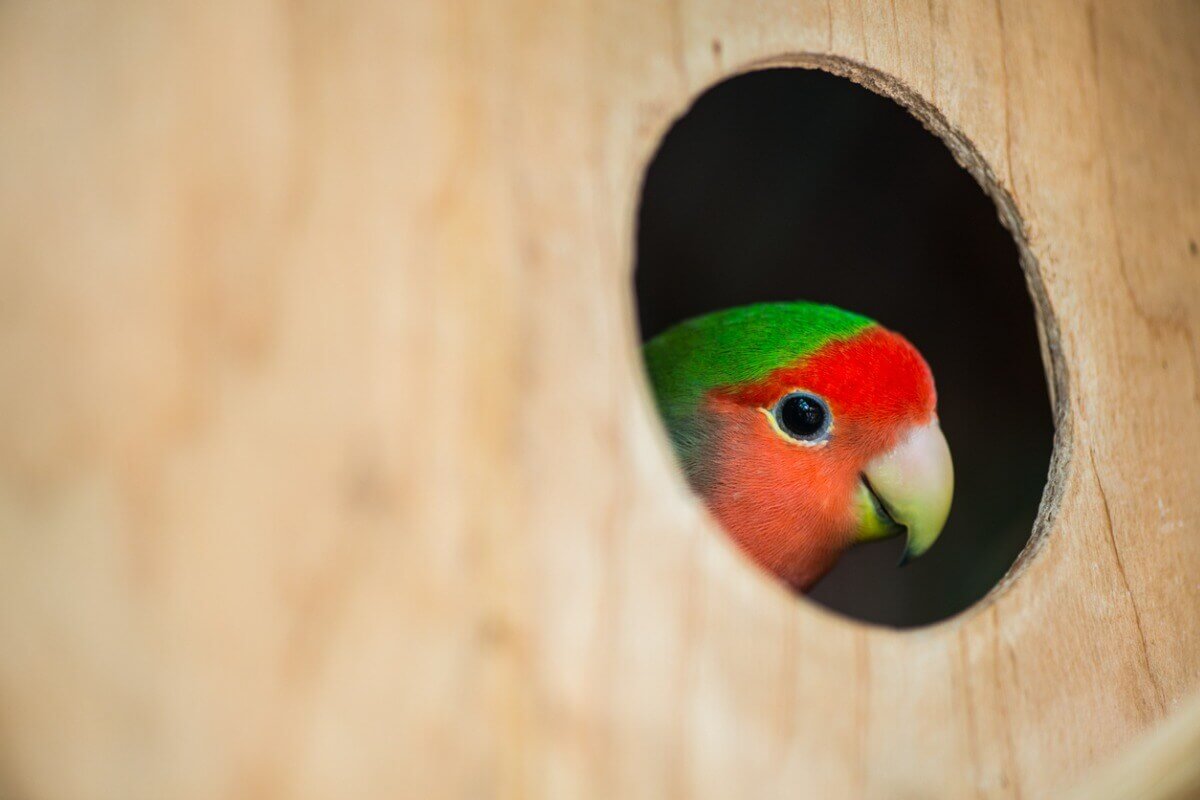11 Interesting Facts About Lovebirds


Reviewed and approved by the biologist Samuel Sanchez
The term Agapornis refers to a genus of birds belonging to the Psittacidae family, which consists of about 9 species that are native to the African continent. More commonly, we know them as lovebirds. You may already know about many characteristics of these animals, such as their faithful attachment to their partners and the beautiful colors of their plumage. However, there are many more interesting facts about lovebirds that we want to share in the following article. Stick around!
These small parrots don’t grow to be much longer than 6 inches and usually feed on fruits and seeds. They also have a long lifespan, ranging from 8 to 10 years in captivity. Here are some interesting facts about lovebirds that you may not be aware of.
1. The origin of their name
The term agapornis translated into ancient Greek (ἀγάπης ὄρνις) is the union of two terms. The first is “agape,” meaning love or affection, and the second is “ornis,” which translates as bird. Therefore, these birds are known as lovebirds.
The females of this genus lay between 3 and 6 eggs once they reproduce.

2. Recent introduction
Although the genus brings together 9 different species, Agapornis fischeri is one of the most popular. Specifically, this animal was discovered in 1882 in Africa by Dr. Gustav Adolf Fischer, to whom it owes its name.
However, it is believed that the species was introduced around 1869 to Europe by the zoologist Alfred Brehem, more precisely to Berlin. Despite this, in 1887 this species was named in honor of Gustav Fischer, by his great friend Anton Reichenow.
3. Loving character
One of the interesting facts about lovebirds is that, like many other birds, this genus includes birds that are characterized by being monogamous. From the moment they find a mate, they form an inseparable union, just as their name indicates. However, if their mate dies, the survivor may look for another partner to share the rest of its life with.
In the same way, lovebirds show a great love for their human companions. They’re birds that require attention and can sometimes be seen asking their owners to caress their feathers. This is due to the strong bond they manage to establish with humans, either alone or in pairs.
Due to their sociality, it’s always best to keep lovebirds in pairs.
4. Territorial nature
Just as they’re loving, lovebirds can sometimes present a strong territorial nature when strangers approach their space. Similarly, if an unknown animal or human isn’t to their liking, they can be very aggressive and attack with their beaks.
5. Easy training
If, as an owner, you dedicate hours and patience to your lovebird, its training can be easier than that of other birds. You can teach your bird to do tricks such as turn on itself, climb your finger or pick up objects with its claws. The lovebird’s intelligence and agility to learn such tricks can be enhanced with occasional treats.
6. Their presence in the world of music
Interestingly, an Argentine pop cumbia band goes by the name of Agapornis or AGP. This band is characterized by a mix of Latin sounds such as cumbia, reggaeton, and pop. Their logo is that of two birds of the Agapornis genre facing each other above a red heart.
7. Water lovers
Another interesting fact about lovebirds is that these animals love to dive into the water, so a good option in captivity is to have a container in which they can cool off (apart from the one they use to hydrate). Occasionally can submerge them under the tap with a little water: You’ll see them shake their wings to clean themselves as well as possible and enjoy a good bath.
8. No sexual dimorphism
The sex of these birds is impossible to determine with the naked eye. Males and females are so similar that a DNA analysis is required to know their gender at the chromosomal level. However, methods (which are not as effective) can be used to determine the sex of a pet, such as looking at the behavior of the birds. Females are believed to be more aggressive and authoritarian.
9. Confidence outside the cage
Lovebirds are playful and curious birds, so it’s important that they have ample space to exercise. Therefore, it’s not a bad idea to let them out of their cage from time to time to stretch their legs and interact with other spaces in your home. Environmental enrichment is essential for these species.
Beware of open sockets and windows if you want to take the lovebirds out of their cage.
10. Colors and couples
The plumage of the lovebird is one of the reasons why they’re so popular in captivity. In general, the most popular colors in this genus of birds are green, yellow, and orange. However, there are also specimens with blue, purple, white, or black tones.
At the same time, as we mentioned above, it’s crucial that these birds be allowed to live in pairs. Although it’s possible to keep a single specimen as a pet and establish a strong bond of love between the bird and its owner, it’s best to take care of a couple that in the future can reproduce and share space.
11. They’re zygodactyls
It may sound strange, but the term zygodactyl refers to the shape of the bird’s claws. In the case of lovebirds, this shape is different from that of many other birds, as two of their toes point forward while the other two toes point backward. Their limbs are prepared to climb trees.
Most birds are anisodactyl, i.e. they have three toes pointing forward and one pointing backward.

As you can see, there are several interesting facts about lovebirds that you probably weren’t aware of. Either way, their care in captivity requires time and attention to learn tricks and, above all, so that they can develop emotionally without falling into depression and other associated conditions. These birds aren’t suitable for all owners.
The term Agapornis refers to a genus of birds belonging to the Psittacidae family, which consists of about 9 species that are native to the African continent. More commonly, we know them as lovebirds. You may already know about many characteristics of these animals, such as their faithful attachment to their partners and the beautiful colors of their plumage. However, there are many more interesting facts about lovebirds that we want to share in the following article. Stick around!
These small parrots don’t grow to be much longer than 6 inches and usually feed on fruits and seeds. They also have a long lifespan, ranging from 8 to 10 years in captivity. Here are some interesting facts about lovebirds that you may not be aware of.
1. The origin of their name
The term agapornis translated into ancient Greek (ἀγάπης ὄρνις) is the union of two terms. The first is “agape,” meaning love or affection, and the second is “ornis,” which translates as bird. Therefore, these birds are known as lovebirds.
The females of this genus lay between 3 and 6 eggs once they reproduce.

2. Recent introduction
Although the genus brings together 9 different species, Agapornis fischeri is one of the most popular. Specifically, this animal was discovered in 1882 in Africa by Dr. Gustav Adolf Fischer, to whom it owes its name.
However, it is believed that the species was introduced around 1869 to Europe by the zoologist Alfred Brehem, more precisely to Berlin. Despite this, in 1887 this species was named in honor of Gustav Fischer, by his great friend Anton Reichenow.
3. Loving character
One of the interesting facts about lovebirds is that, like many other birds, this genus includes birds that are characterized by being monogamous. From the moment they find a mate, they form an inseparable union, just as their name indicates. However, if their mate dies, the survivor may look for another partner to share the rest of its life with.
In the same way, lovebirds show a great love for their human companions. They’re birds that require attention and can sometimes be seen asking their owners to caress their feathers. This is due to the strong bond they manage to establish with humans, either alone or in pairs.
Due to their sociality, it’s always best to keep lovebirds in pairs.
4. Territorial nature
Just as they’re loving, lovebirds can sometimes present a strong territorial nature when strangers approach their space. Similarly, if an unknown animal or human isn’t to their liking, they can be very aggressive and attack with their beaks.
5. Easy training
If, as an owner, you dedicate hours and patience to your lovebird, its training can be easier than that of other birds. You can teach your bird to do tricks such as turn on itself, climb your finger or pick up objects with its claws. The lovebird’s intelligence and agility to learn such tricks can be enhanced with occasional treats.
6. Their presence in the world of music
Interestingly, an Argentine pop cumbia band goes by the name of Agapornis or AGP. This band is characterized by a mix of Latin sounds such as cumbia, reggaeton, and pop. Their logo is that of two birds of the Agapornis genre facing each other above a red heart.
7. Water lovers
Another interesting fact about lovebirds is that these animals love to dive into the water, so a good option in captivity is to have a container in which they can cool off (apart from the one they use to hydrate). Occasionally can submerge them under the tap with a little water: You’ll see them shake their wings to clean themselves as well as possible and enjoy a good bath.
8. No sexual dimorphism
The sex of these birds is impossible to determine with the naked eye. Males and females are so similar that a DNA analysis is required to know their gender at the chromosomal level. However, methods (which are not as effective) can be used to determine the sex of a pet, such as looking at the behavior of the birds. Females are believed to be more aggressive and authoritarian.
9. Confidence outside the cage
Lovebirds are playful and curious birds, so it’s important that they have ample space to exercise. Therefore, it’s not a bad idea to let them out of their cage from time to time to stretch their legs and interact with other spaces in your home. Environmental enrichment is essential for these species.
Beware of open sockets and windows if you want to take the lovebirds out of their cage.
10. Colors and couples
The plumage of the lovebird is one of the reasons why they’re so popular in captivity. In general, the most popular colors in this genus of birds are green, yellow, and orange. However, there are also specimens with blue, purple, white, or black tones.
At the same time, as we mentioned above, it’s crucial that these birds be allowed to live in pairs. Although it’s possible to keep a single specimen as a pet and establish a strong bond of love between the bird and its owner, it’s best to take care of a couple that in the future can reproduce and share space.
11. They’re zygodactyls
It may sound strange, but the term zygodactyl refers to the shape of the bird’s claws. In the case of lovebirds, this shape is different from that of many other birds, as two of their toes point forward while the other two toes point backward. Their limbs are prepared to climb trees.
Most birds are anisodactyl, i.e. they have three toes pointing forward and one pointing backward.

As you can see, there are several interesting facts about lovebirds that you probably weren’t aware of. Either way, their care in captivity requires time and attention to learn tricks and, above all, so that they can develop emotionally without falling into depression and other associated conditions. These birds aren’t suitable for all owners.
All cited sources were thoroughly reviewed by our team to ensure their quality, reliability, currency, and validity. The bibliography of this article was considered reliable and of academic or scientific accuracy.
- Dyck, J. (1971). Structure and colour-production of the blue barbs of Agapornis roseicollis and Cotinga maynana. Zeitschrift für Zellforschung und Mikroskopische Anatomie, 115(1), 17-29. Recogido el
This text is provided for informational purposes only and does not replace consultation with a professional. If in doubt, consult your specialist.








